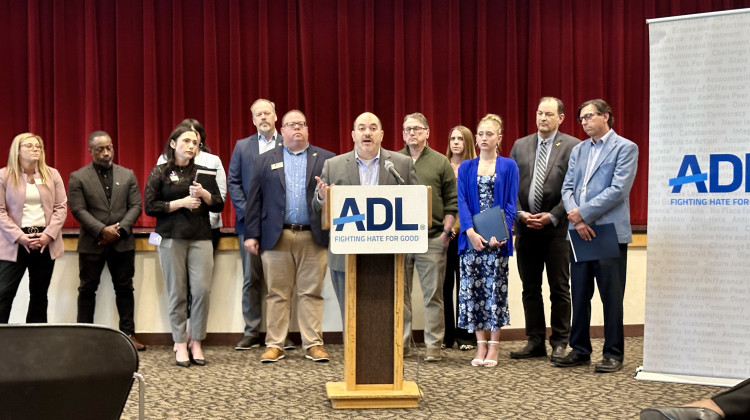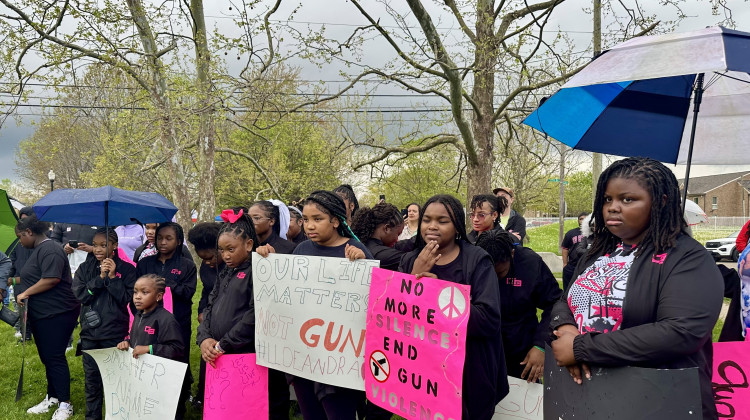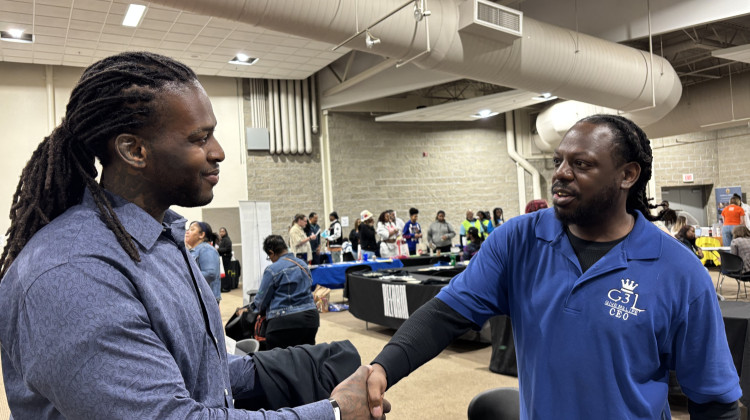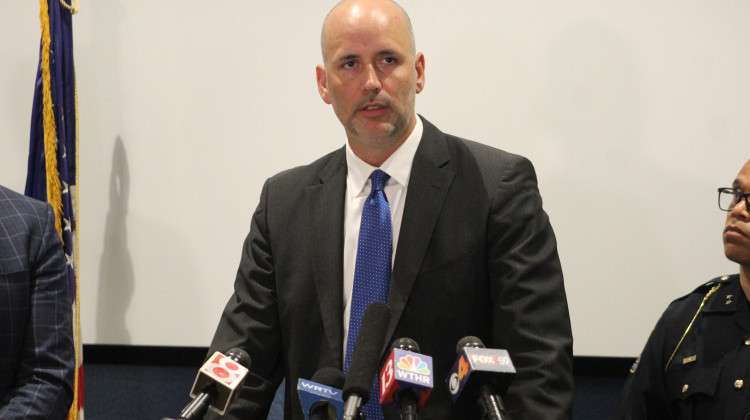
"Any way you cut the data, the trends are not good," said Goldenberg in Indianapolis last week.
Zak Cassel / WFYIBomb threats. Pamphlets that proclaimed “Synagogue of Satan.” Signs at protests that read: “From the river to the sea, Palestine will be free.”
These are among incidents counted in Indiana in an annual analysis of antisemitism by the Anti-Defamation League. The national organization monitors and advocates against hatred of Jewish people and other minorities.
Leaders from Indiana Jewish organizations gathered with ADL staff last week at the Jewish Community Center of Indianapolis to release the data and share their experiences. They included the Indianapolis Jewish Community Relations Council, JCC Indianapolis, Indiana University Hillel, and the Jewish Federation of Greater Indianapolis.
They expressed alarm at the latest results.
“The total is the highest number on record since ADL began tracking antisemitic incidents 46 years ago,” said David Goldenberg of the national analysis. Goldenberg is the director of the organization’s Midwest regional office.
Anti-Jewish activity increased statewide last year again, the ADL said, adding to a swell since 2020 in incidents of harassment, vandalism, and in some cases violence — in the Midwest and the United States.
Nationally, there was a slight increase in all incidents in 2024 after a large spike in 2023, which the ADL attributes to the Israel-Hamas conflict.
Of all states, Indiana had the twelfth highest number of incidents, which increased from 59 in 2023 to 142 last year. The ADL categorized over 80 percent of these as harassment in the audit.
A third of the antisemitic activity in Indiana last year impacted the Indianapolis-area Jewish community.
Ruthie Rosenberg, a senior at North Central High School, spoke at the press conference where the results were shared. She said she was doxxed because of her identity.
“I have personally experienced having my picture, name, and school posted on social media with a PSA to those who followed the account that I am Jewish and to watch out for me,” she said. “I didn’t even know the person who posted this. They recognized I was Jewish and wanted to put a target on my back.”
Rosenberg said she’s had teachers who spoke against Israel in the Israel-Hamas conflict, making it difficult for her to be open about being Jewish. She said she’s had to advocate for herself.
The analysis didn’t include any acts of violence in Indiana last year. Two occurrences of violence were reported in 2023.
Antisemitic incidents fell into two categories: harassment and vandalism.
Harassment accounted for most of Indiana’s encounters: at least 116 incidents led in the analysis. The nature of the incidents varied.
Bomb threats made up 32 of them. Of these, 26 of the threats were directed at synagogues on just two single dates last year.
“We’re going to take all of them seriously. But then, at the same time, for instance, we were able to discover that they were a hoax,” said Suzanne Rothenberg, a spokesperson for the ADL’s Midwest office. “Every single one of them was investigated, and every single one of them was untrue.”
Secure Community Network is an organization that works to build a “security shield over the North American Jewish community” by monitoring and acting on threats, securing facilities, and coordinating with law enforcement and Jewish institutions.
Bradley Swim is the regional security advisor for Indiana. He’s a former FBI agent who investigated domestic violent extremism. He said bomb threats can be made by single individuals. If that person is arrested, it can prevent multiple threats against different institutions across the country.
“We can be notified when, let’s say, synagogues on the West Coast receive a bomb threat,” he said. “I can give advance notice to community contacts in Indiana to say, ‘Hey, just so you know, if you get bomb threats from this sender, we know that these threats have already been received in other places.’”
In other cases in the ADL analysis, symbols like the Star of David or swastikas were used against individuals or organizations, for example by digging them into the snow in front of a family’s home.
Incidents of harassment also took on two other main themes: those occurring at protests and propaganda distribution.
The incidents that the ADL counted at protests often referred to different slogans either against Israel or Zionism, or that supported Palestine. Students at universities across the state organized many of these protests.
Nationally, the organization reported that 58 percent of all incidents were related to Israel — a first. Almost half of these antisemitic expressions occurred at protests, according to the ADL.
“At Indiana University, students have experienced fear, isolation, and a growing sense of vulnerability,” said Jeff Linkon, the executive director of IU Hillel, an organization that supports Jewish students and life on campus.
He said that some of these experiences were associated with an encampment on IU’s Dunn Meadow, “which had become a source of intimidation and distress for many students, many guests visiting campus, and certainly for the Jewish community.”
In one case, protestors at IU allegedly spit on some Jewish students, according to the ADL data. The university closed down the encampment last August.
IU Hillel has increased its collaboration with Secure Community Network and law enforcement, and it plans to increase its safety and security training, as well as mental health and wellness services, Linkon said.
A long-standing practice called fliering, used to spread white supremacist and antisemitic propaganda, comprised a notable chunk of incidents of harassment last year. The tactic is often used for both intimidation and recruitment.
Sometimes, fliers are passed out at events, but often they are distributed anonymously in the middle of the night to areas like residential neighborhoods. Last year an individual associated with a splinter group of the Ku Klux Klan littered anti-immigrant propaganda around Central Indiana communities after the November presidential election.
In Indianapolis, Carmel, and a handful of other cities around the state, perpetrators left fliers in little free libraries — community boxes posted in public spaces where people can take and leave books for free. These accounted for at least 14 incidents in the ADL’s data.
Rothenberg of the ADL has used these community libraries.
“Even two houses down from me, the little free library had a Nazi flier in it,” she said.
They work with law enforcement and partner organizations to clean fliers up as quickly as possible, minimize impact, and investigate who is behind the actions.
“One of the things that’s been really frustrating about hate littering is that Indiana currently doesn’t have a law against littering on private property with the intent to intimidate somebody based on their identity,” said Rothenberg.
A group distributed propaganda in Lafayette during the recent Passover weekend that included the antisemitic trope of blood libel and smeared Jewish people as pedophiles, said Goldenberg of the ADL. He shared photos of the fliers with WFYI.
Propaganda distributed by antisemitic and white supremacist individuals and groups has increased, according to the organization.
“It seems like something minor on the surface, but it becomes very, very personal,” said Swim of Secure Community Network, “feeling very directed when those things are received on somebody’s personal property — somebody wakes up in the morning and finds these.”
Incidents of vandalism in Indiana rose from 10 in 2023 to 26 in 2024.
These included spray painting swastikas, the Star of David, or other graffiti on buildings such as synagogues, Israeli flags, or signs. In one instance, Stars of David were carved into a university student’s dorm room door, according to the data.
“The Jewish community is being targeted with hate in ways that we have not experienced in generations. You’ll be hard pressed to find anyone in the Jewish community who either has not experienced antisemitism firsthand or knows someone who has. It’s no more than one degree of separation,” said Goldenberg.
Contact WFYI data journalist Zak Cassel at zcassel@wfyi.org.
 DONATE
DONATE








 Support WFYI. We can't do it without you.
Support WFYI. We can't do it without you.